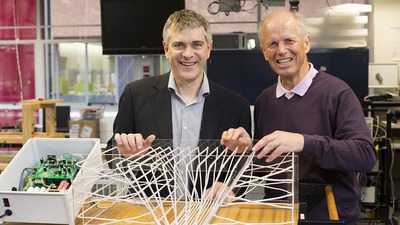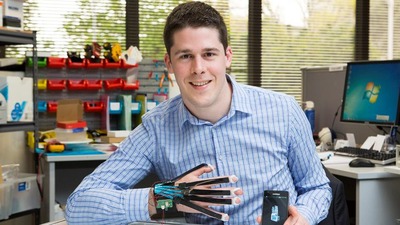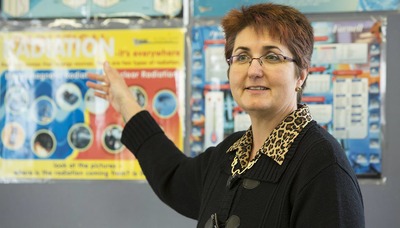NZ Prime Minister's Science Prizes awarded
The 2013 Prime Minister’s Science Prizes were this week awarded at the Royal Society of New Zealand in Wellington. With a total of $1 million in prize money, the awards aim to highlight the contribution science makes to New Zealand’s economy and encourage students and future generations into scientific endeavours.
Prime Minister’s Science Prize - Distinguished Professor Emeritus John Boys and Professor Grant Covic

Distinguished Professor Emeritus John Boys and Professor Grant Covic, from the University of Auckland’s Faculty of Engineering, were awarded the Prime Minister’s Science Prize for their achievements in wireless power transfer.
The engineers pioneered wireless or inductive power transfer (IPT) technology and coined IPT terminology globally, yet for years they left meetings with potential funders empty-handed.
“We couldn’t get funding because people said, ‘That’s impossible’,” said Professor Boys. “The only people who would give us money were [the university’s commercialisation arm] UniServices - all the other funding agencies weren’t interested.”
But in 1990, Japanese company Daifuku invested significantly in the engineers’ research. They responded by creating the world’s first fully controllable IPT system combining high efficiency and high power - technology which has enabled Daifuku to become one of the world’s largest automated cleanroom manufacturers.
Now at least 70% of the world’s LCD screens and other electronic equipment requiring computer chips are manufactured on systems using their technology. Vehicle brands such as Mercedes-Benz, BMW and Audi also rely on it, as do theme park rides and roadway lighting in traffic tunnels throughout the world.
In the late 1990s, the team turned to inductive power and charging systems for electric vehicles (EVs), automatic guided vehicles and robotics. In May 2010, the company HaloIPT was spun out to develop the technology further for EVs; in late 2011, it was sold to Qualcomm, a United States Fortune 500 company. In the past four years alone, their work has attracted more than $20 million in research funding plus additional income from licence fees.
The engineers’ next challenge is developing in-road wireless charging, eliminating the need for plug-in battery chargers and enabling cars to recharge as they travel along highways. They aim to lower the cost and battery weight, increase the power and make cars more efficient while using green energy, such as solar or wind.
“We’ve been told the idea of inductive power systems in roads is too way out to have any real chance of success,” said Professor Boys, but the words of others have never stopped the team before. They have garnered their success through blue sky research exploring what people may need in five years, “before they recognise they even need it”, said Professor Covic.
The prize money will enable such research alongside partners so New Zealand remains at the cutting edge of IPT. As a result, the engineers believe within five years their technology will be able to recharge electric vehicles from in-road systems over short stretches of selected highway and buses will be able to recharge as they drive over extended bus stops or lanes.
The Prime Minister’s MacDiarmid Emerging Scientist Prize: Dr Benjamin O’Brien

Dr Ben O’Brien has won the 2013 Prime Minister’s MacDiarmid Emerging Scientist Prize for pioneering the development of small, light, soft, stretchy sensors that can measure movement of the human body and transmit the information to a smartphone app. Earlier this year, he formed a company - StretchSense - to sell the technology to global customers in healthcare, rehabilitation, sports training, animation and gaming.
“Our sensors are so precise and reliable that they can be used for anything you want to measure,” said O’Brien. “One example is rehabilitation where a healthcare professional wants to track something, like how an injury is improving over time.”
O’Brien’s prize is worth $200,000, with $150,000 of the money to be used for further research. He plans to take the technology to the next level by developing an intuitive, skintight undergarment that can monitor and interpret body language, gestures and posture to accurately read the emotions of the wearer. His goal is to create an ‘emotionally aware’ body suit.
“If you become frustrated while sitting at a computer you can get up and walk away, but that’s not the case if the computer is embedded in your t-shirt or your shoes,” said O’Brien. “Wearable technology that can listen to body language is so far an unexplored area, but I see it as a crucial enabler to this fast-growing industry.”
O’Brien received his PhD in bioengineering from the University of Auckland in 2010. He received a two-year Rutherford Foundation Postdoctoral Fellowship to work in the Biomimetics Laboratory of the university’s Bioengineering Institute and, in 2011, spent six months at the Microsystems Systems for Space Technologies Lab at École Polytechnique Fédérale de Lausanne in Switzerland to work on miniaturising his technology. StretchSense was spun out of the Biomimetics Laboratory.
O’Brien says StretchSense’s point of difference is its ability to customise sensors to the needs of the customer, providing them with “everything they need to take the technology and put it straight into their product”.
The Prime Minister’s Science Teacher Prize: Fenella Colyer

Fenella Colyer, who is Head of Physics at Manurewa High School, has won the 2013 Prime Minister’s Science Teacher Prize for reversing a trend of falling science class sizes at her college. She is demystifying science by writing educational modules tailored to students’ differing abilities and interests and making class topics relevant to teenagers.
“It may not be easy for teachers to do individual education plans for each student but it’s easy for all teachers to prevent students switching off by finding topics that interest them and fit the curriculum,” said Colyer.
The journey of Polynesian explorers who colonised New Zealand, the physics principles involved in felling huge trees to make waka, navigation skills, the elasticity and strength of flax and the physics of sport are likely topics for Colyer students. She has been the driving force behind a 30% increase in the number of Maori and Pasifika students studying science at Manurewa High in the past two years, with pass rates rising to 81%.
Girls now outnumber boys in Manurewa’s senior classes, 13 students have won major regional or national science awards, others have been selected for and excelled at university science challenges, summer schools or science symposiums in New Zealand and overseas and one has attended Space Camp in the United States.
A motivating force for Colyer has been her experience as a parent of four children with differing educational abilities, ranging from the gifted to special needs, and feeling they weren’t being catered for in the education system.
“It’s such a thrill to see a less able student no longer scared or intimidated by science, when they realise they ‘get’ it, enjoy it and pass when they think they’re going to fail. Sometimes the most unlikely people are the most successful,” she said.
Manurewa Principal Salvatore Gargiulo has earmarked some the school’s $100,000 share of the prize money to establish a science academy to ensure the subject earns the same respect as more high-profile interests, such as sport.
The Prime Minister’s Future Scientist Prize: Thomas Morgan

Tom Morgan, a Year 13 student at Marlborough Boys’ College, won the 2013 Prime Minister’s Future Scientist Prize for carrying out what judges describe as some of the most detailed experiments they have seen by someone at his level.
Morgan grew oyster mushrooms in the dark and then exposed them to UV light for varying periods of time before testing their concentration of ergocalciferol, or Vitamin D. Without access to the sophisticated laboratory equipment normally used to extract and measure Vitamin D, he developed an inexpensive and simple technique using equipment that is available in many laboratories.
His results show that there is a strong correlation between length of exposure to UV light and the concentration of Vitamin D in oyster mushrooms. This highlights the potential for others to rapidly investigate ways to improve Vitamin D concentrations in foodstuffs with a goal of addressing Vitamin D deficiency, which is linked to osteoporosis - a major cause of suffering and disability around the world.
“In my background reading on Vitamin D, I learned about the growing worldwide problem with osteoporosis, something that will become more and more of an issue as the number of elderly people increases,” Morgan said. “I also came to understand that there are not a lot of easily available foods that contain high levels of Vitamin D for people who aren’t getting it through sunlight.”
Morgan hopes his research might encourage growers to think about applying UV light treatment to mushrooms and then marketing them as being rich in Vitamin D, delivering health food benefits for segments of the population.
The Prime Minister’s Science Media Communication Prize: Dr Siouxsie Wiles

Dr Siouxsie Wiles, a microbiologist at the University of Auckland, has won the 2013 Prime Minister’s Science Media Communication Prize for her communication of a wide range of scientific issues.
Dr Wiles leads the University of Auckland’s Bioluminescence Superbugs Group, focusing on how glowing bacteria can help scientists better prevent and fight microbial infections such as food poisoning, tuberculosis and hospital superbugs.
As a media commentator and blogger, she regularly gives public talks about science and was one of the faces of last year’s public engagement campaign for the National Science Challenges. She has made a number of popular animations that introduce the public to glowing creatures such as fireflies and the Hawaiian Bobtail squid and how their light can be used in science.
Dr Wiles does much of her science communication in her spare time and sees it as a fundamental part of being a scientist. “I … believe our profession has a responsibility to be approachable and explain things to the public in a jargon-free way,” she said. “It’s also important because many New Zealand researchers get taxpayer funding to carry out their research. If we want to continue being funded, it’s vital that we tell the public what we are doing and why it is important.”
Winning the prize sees Dr Wiles receive $50,000, with another $50,000 allocated for further developing her science media communication skills. She plans to devote some of the prize money to writing a children’s book on bioluminescence with her seven-year-old daughter. She is also producing an animation about the anglerfish and will create a website called GlowHub to house her films and a series of short documentaries on the work of cutting-edge Kiwi scientists.
Other initiatives she plans include running workshops in which she and other leading science communicators will teach scientists how to craft their stories into two-minute science animations and setting up a fund to work with artists on works inspired by bioluminescence and microbiology.
For more on the prize winners, visit http://www.pmscienceprizes.org.nz/about/winners-2013/.
How librarians can help maintain image integrity
By sharing best practice and providing useful resources, librarians can support researchers in...
Winners announced for 2025 Australian Museum Eureka Prizes
Now in their 35th year, the Australian Museum Eureka Prizes continue to highlight some of the...
"Damning" review of Forensic Science Queensland released
The review of the troubled forensic service provider reveals unreliable results,...





